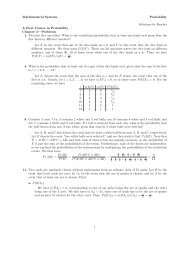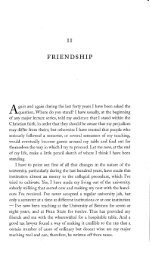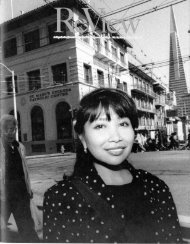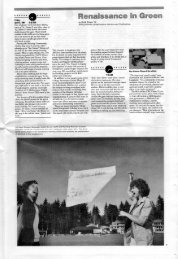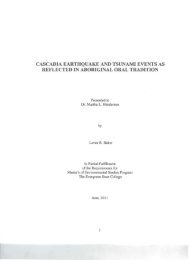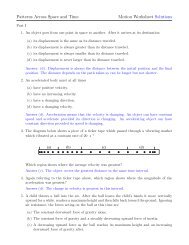V12 #1 November 1990 - Archives - The Evergreen State College
V12 #1 November 1990 - Archives - The Evergreen State College
V12 #1 November 1990 - Archives - The Evergreen State College
You also want an ePaper? Increase the reach of your titles
YUMPU automatically turns print PDFs into web optimized ePapers that Google loves.
I<br />
BOTANIST<br />
by Keith Eisner '80<br />
Let's start small. Consider 3.5 million board feet. That's the<br />
estimated amount of timber that would be removed from the sale of<br />
100 or so acres of old growth forest in Washington's Mt. Baker-<br />
Snoqualmie National Forest.<br />
Three-and-a-half million of anything is tough to conceive.<br />
But let's put it this way: 3.5 million board feet would cover every<br />
inch of <strong>Evergreen</strong>'s Red Square (from CAB to Lecture Hall,<br />
Clocktower to knoll) to a height of over 15 feet. It's enough lumber<br />
to frame at least 270 three-bedroom houses. Stumpage value for that<br />
amount rings in at about $1,500,000. Add several million more<br />
dollars generated in processing, truckers' wages, millwork, retail<br />
sales and other support industries. Anyway you cut it, it's a lot of<br />
lumber packing a huge economic wallop that affects hundreds if not<br />
thousands of lives.<br />
Yet 3.5 million board feet is only a fourth of the amount of<br />
timber that the Darrington District is required to sell this year. <strong>The</strong><br />
Darrington District, 60 miles northeast of Seattle, is only one of five<br />
districts in the Mt. Baker-Snoqualmie National Forest which as a<br />
whole is mandated to sell 45 million board feet of timber this year.<br />
<strong>The</strong> Mt. Baker Forest is one of six national forests in Oregon and<br />
Washington. Altogether nearly 4 billion board feet of old growth<br />
timber on federal lands is slated to be cut in Oregon and Washington<br />
next year.<br />
Consider now the Botrychium montanum, also known as<br />
the grape fern or moonwart. "It looks like something Bart Simpson<br />
would draw," says Forest Service botanist Laura Potash '78. She<br />
sketches a bony, angular-looking stalk, a warty thing one could well<br />
imagine growing on the moon. <strong>The</strong> particular specimens Potash<br />
found were one-half-inch tall. A hundred would fit in the palm of<br />
your hand, and a child's breath would blow them away.<br />
Puny and abstract as the moonwart, bog orchid, sedges and<br />
other such plants may seem against the million dollar stacks of<br />
lumber, they are of great importance to the U.S. Forest Service<br />
which recently hired Potash to develop a system of study, identification<br />
and inventory for the Mt. Baker-Snoqualmie National Forest.<br />
She is the first federal botanist hired for that area.<br />
Before anyone—logger or Earth Firster!—raises fears or<br />
hopes about a botanist sidetracking a timber sale, Potash is quick<br />
and emphatic about her impartiality. "I wouldn't last two seconds in<br />
the Forest Service if I acted in a manner to favor one side or the<br />
other of the old growth issue. I don't have the authority to say this<br />
should or shouldn't be cut.<br />
My job is to say this is the plantlife that exists in a certain<br />
area. This is what those plants need to survive."<br />
THE EVERGREEN REVIEW<br />
continued on page 14





